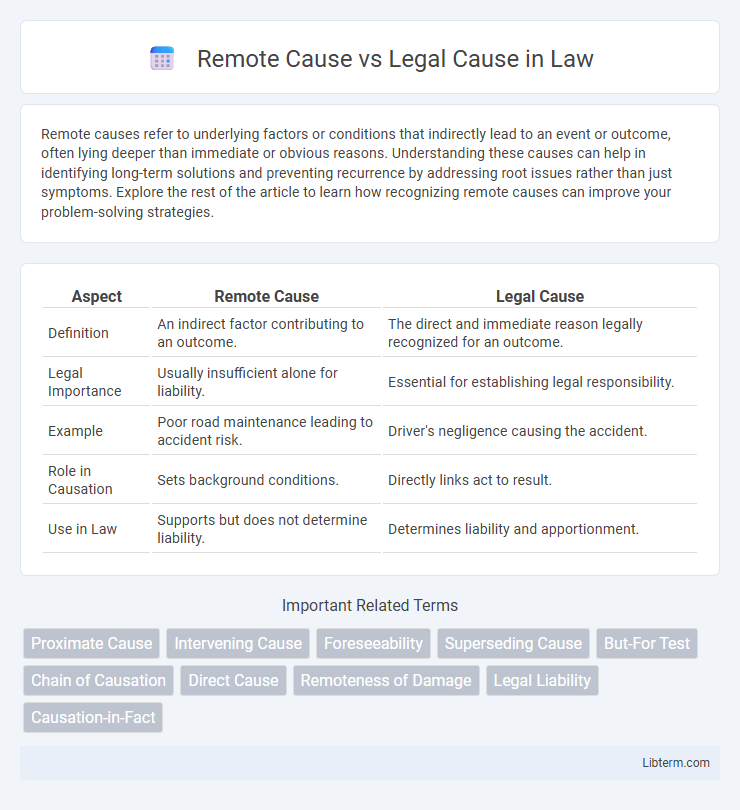Remote causes refer to underlying factors or conditions that indirectly lead to an event or outcome, often lying deeper than immediate or obvious reasons. Understanding these causes can help in identifying long-term solutions and preventing recurrence by addressing root issues rather than just symptoms. Explore the rest of the article to learn how recognizing remote causes can improve your problem-solving strategies.
Table of Comparison
| Aspect | Remote Cause | Legal Cause |
|---|---|---|
| Definition | An indirect factor contributing to an outcome. | The direct and immediate reason legally recognized for an outcome. |
| Legal Importance | Usually insufficient alone for liability. | Essential for establishing legal responsibility. |
| Example | Poor road maintenance leading to accident risk. | Driver's negligence causing the accident. |
| Role in Causation | Sets background conditions. | Directly links act to result. |
| Use in Law | Supports but does not determine liability. | Determines liability and apportionment. |
Introduction to Remote Cause and Legal Cause
Remote cause refers to an indirect or less immediate factor in the chain of events leading to a legal consequence, often too distant to establish liability. Legal cause, also known as proximate cause, signifies the direct and primary factor that legally connects an act to its consequence, establishing accountability in law. Distinguishing between remote cause and legal cause is essential in determining fault and awarding damages in tort and criminal cases.
Defining Remote Cause in Law
Remote cause in law refers to an indirect or distant factor that contributes to an event but lacks immediate or direct connection with the outcome. It is distinguished from legal cause, which involves a direct and proximate link essential for establishing liability. Courts often analyze foreseeability and proximity to determine whether a cause is remote or legal, impacting the attribution of responsibility in tort and contract cases.
Understanding Legal Cause (Proximate Cause)
Legal cause, also known as proximate cause, refers to an event sufficiently related to an injury that the courts consider it the primary cause for liability purposes. It limits liability to consequences that bear a reasonable connection to the negligent act, excluding remote or unforeseeable results. Understanding legal cause is essential in tort law to establish a clear link between the defendant's actions and the plaintiff's harm.
Key Differences Between Remote and Legal Cause
Remote cause refers to an initial or indirect factor in a chain of events, while legal cause directly connects an action to a legally recognized harm or consequence. Legal cause must be a proximate cause, meaning it is sufficiently related to the injury for liability to be assigned, whereas remote cause may be too indirect or attenuated to establish legal responsibility. The key difference lies in the necessity of proximate causation for legal cause, ensuring accountability only for reasonably foreseeable outcomes of an action.
Importance of Causation in Legal Proceedings
Causation is a critical element in legal proceedings, establishing the direct link between an act and the resulting harm to determine liability. Remote cause refers to a cause that is too indirect or unforeseeable to hold a party accountable, whereas legal cause, or proximate cause, is the primary reason an injury occurred, satisfying the foreseeability and directness criteria. Accurate identification of legal cause ensures fair judgment by limiting liability to consequences reasonably connected to the defendant's actions.
Case Law Illustrating Remote vs. Legal Cause
Case law illustrating remote versus legal cause often hinges on the foreseeability of harm and the directness of the causal link, as seen in *The Wagon Mound (No. 1) [1961]* where the court held that only foreseeable damage qualifies as legal cause. In *Palsgraf v. Long Island Railroad Co. (1928)*, the court distinguished between remote cause and legal cause by ruling that the defendant's negligence was not the proximate cause of the plaintiff's injuries due to the lack of foreseeability. These cases emphasize that legal cause requires a closer and foreseeable connection between the defendant's act and the harm suffered, whereas remote cause relates to consequences too indirect or unforeseeable to attribute legal liability.
Factors Influencing the Determination of Legal Cause
Factors influencing the determination of legal cause include foreseeability, which assesses whether the harm was a predictable consequence of the defendant's actions, and proximate cause, examining the directness of the connection between the action and the injury. Legal cause also considers intervening causes that may break the causal chain, alongside policy considerations that limit liability to prevent infinite responsibility. Courts evaluate these elements to distinguish legal cause from remote cause, ensuring liability is assigned only when the defendant's conduct is sufficiently related to the harm.
Challenges in Proving Causation
Proving causation faces challenges in distinguishing remote cause from legal cause due to the complexity of linking specific actions to outcomes within acceptable legal boundaries. Courts must determine whether an event is sufficiently connected to the harm, avoiding overly attenuated chains that break liability. Establishing proximate cause requires robust evidence demonstrating that the defendant's conduct was a substantial factor in producing the legally recognized injury.
Impact of Remote and Legal Cause on Liability
Remote cause limits liability by establishing a distant or indirect connection between an action and the resulting harm, making it harder to hold a party accountable. Legal cause, also known as proximate cause, sets a clearer threshold for liability by requiring that the harm be a foreseeable outcome of the defendant's conduct. Courts focus on legal cause to determine liability, ensuring that only reasonably foreseeable consequences are attributed to the defendant's actions.
Conclusion: The Role of Causation in Justice
The distinction between remote cause and legal cause is crucial in determining liability and ensuring fair justice outcomes. Legal cause narrows down the causal chain to proximate factors that have a direct and foreseeable impact, thereby preventing endless liability for remote causes that are too attenuated. Proper application of causation principles ensures accountability is assigned appropriately, balancing fairness and legal responsibility in judicial decisions.
Remote Cause Infographic

 libterm.com
libterm.com